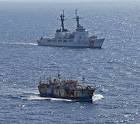 Xenia Naka. By results of examination of the administration of the Japanese city of Nemuro in Hokkaido that is the Center of drift-net fishing, harmful to Eastern areas of Hokkaido in the case that Russia will impose a ban on Drift-net fishing in its exclusive economic zone will be 25 billion yen (about 203 million dollars). Xenia Naka. By results of examination of the administration of the Japanese city of Nemuro in Hokkaido that is the Center of drift-net fishing, harmful to Eastern areas of Hokkaido in the case that Russia will impose a ban on Drift-net fishing in its exclusive economic zone will be 25 billion yen (about 203 million dollars).
The law prohibiting drift-net fishing was passed by the Parliament on 10 June. If it will be on Wednesday passed by the Federation Council and signed by the President of Russia, from January 1, 2016, Drift-net fishing will be prohibited. Currently in the far East of Russia this form of fishing are 35 Japanese and 16 of the Russian courts. They overlap to 1, 6 thousand kilometers of the sea on the approach of the salmon to spawn.
Drift is called a fish with a long, long networks - drifters. They are placed in the path of the fish that are spawning. Eventually caught mixed populations of different species of salmon, and spawning stock. Every year in Russia this form of fishing produces about 17 thousand tons of salmon, the most valuable species - sockeye - about 10 thousand tons.
As reported, according to the Ministry of agriculture, forestry and fisheries, the catch of salmon on the Japanese Islands, including other types of fishing network, is 150 thousand tons, from them on Drift-net fishing in its 200-mile exclusive economic area of Russia, we have 6, 4 thousand tons.
Some of the reviewers on the Japanese Islands believe that environmental arguments for the ban are only a pretext, in reality it is retaliatory measures against Russia imposed by Japan on penalties in connection with the situation in Ukraine.
Drift-net fishing in the area of the South Kuril Islands has historical roots, highlights TV: this method Japanese fishermen were extracted fish here until the Second world war, when this area belonged to Japan. The center of this fishery was the city of Nemuro in Hokkaido. In 1977 with the introduction of the then 200-mile exclusive economic zone of the USSR fishery was discontinued. Now on the basis of bilateral intergovernmental agreements are defined quotas for fishing, for that Japan pays Russia. The peak of production, including fishing on the high seas were in 1955, when it was caught 100 thousand tons. This year, the production volume is 1, 9 thousand tons.
According to the estimates of Russian lawmakers, ban drift-net fishing in the EEZ of the Russian Federation will provide an opportunity to increase the supply of fish products to the market of the Russian Federation in the amount of about 5 billion rubles. In the fishing industry will create an estimated 4 thousand jobs, and in the budgets of all levels will get more than five hundred million rubles.
sections: Politics
|